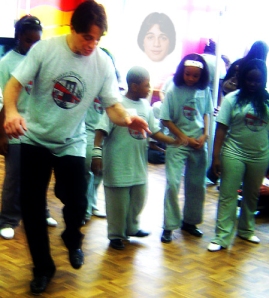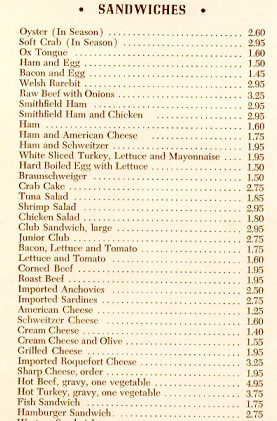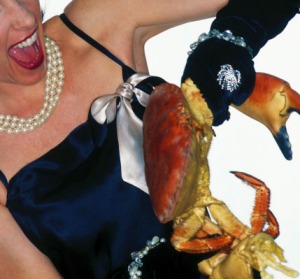
Have you ever watched a crab on the shore crawling backward in search of the Atlantic Ocean, and missing? That’s the way the mind of man operates.
– H. L. Mencken
Crab cakes and Tony Danza bother me. I love crab meat – any kind of crab, any type of meat. It is one of the best ingredients on Earth, yet it is horribly misused. It is far superior to shrimp and second only to lobster in my love affair with exoskeletal meat muppets. I have never had a Maryland crab cake that measured up to the quality of the man ingredient.
It would be cool to have a beer with Tony Danza or maybe play foosball with him, but I don’t want to see him do Shakespeare, tap dance or do Tony Bennett’s act. Everything in its place. Somehow the humble crab cake has become Tony Danza as King Lear I prefer the Tony Danza from Taxi. I prefer crab cakes that are simple and authentic.

Don’t try too hard to be young. Be who you are.
Everyone kept telling me, Just be yourself. Be yourself. I kept thinking, there’s got to be more to it than that!
– Tony Danza
The humble blue crab was a staple of the Chesapeake Bay area long before Europeans “discovered” it. The crab cake probably followed soon after the white devils arrived. There is a beautiful and intelligent recipe for crab cakes from 1660 in the amazing cook book by French-trained Englander Robert May.
Crab harvesting became a genuine industry as time went by and exploded when refrigeration became feasible. Accounts from the the 1930’s and 1940’s tell of bar owners giving away crabs in bars to keep people drinking. Do doubt, the crab meat made from the lesser types of meat were quite inexpensive also, Then as now the bigger pieces commanded higher prices and the type with smaller lump, claw and backfin meat were kept for the working class. The ubiquitous spice mix Old Bay formulated in the 1940’s was popular with tavern owners because it stimulated the thirst of beer drinkers and kept them in the bar.
Maryland crab cakes used to be for the hoi polloi, now they are faux hoity toity. The new driving force in demand and tastes and preferences for crab cakes is the hoity polloi.

So how did the lowly crab cake become an objection of almost religious veneration and conflict? Once the homely meatloaf of the sea, is now a luxury good. The homely girl with the nice personality is now the hot cheerleader – demand has increased and her currency has risen.
Crab cakes have become an objection of conspicuous consumption in Maryland. The American economist Thorsten Veblen developed the theory of conspicuous consumption to explain why people prefer more expensive versions of the same goods. Imagine someone ordering Grey Goose vodka for a dirty martini where they pour rancid olive juice into the most expensive vodka on the bar. A few quotes from Thor:
Conspicuous consumption of valuable goods is a means of reputability to the gentleman of leisure.
The basis on which good repute in any highly organized industrial community ultimately rests is pecuniary strength; and the means of showing pecuniary strength, and so of gaining or retaining a good name, are leisure and a conspicuous consumption of goods
In order to stand well in the eyes of the community, it is necessary to come up to a certain, somewhat indefinite, conventional standard of wealth.
– Thorsten Veblen

Crab cakes started out as peasant food. Over time it developed a regional cachet. As incomes rose and working class people became middle class they clung to their roots and fetishized the crab cake. It seems very much like sports, the modern unthinking man’s religion. A local allegiance develops, a type of tribal identity and pride, something that the working man can afford. All good.
The addiction to sports, therefore, in a peculiar degree marks an arrested development in man’s moral nature.
– Thorstein Veblen
Haussner’s Restaurant’s menu from 1977 lists a crab cake sandwich as $2.75, the same as a sardine sandwich and a “hamburger sandwich”.


Adjusted for inflation a crab cake sandwich is $9.66, in 2009 dollars, which sounds about right. That seems a little steep for a sardine or hamburger sandwich. Hamburger sandwich? Adorable. Haussner’s was trapped in some kind of time warp. The point here is that a crab cake was not expensive if it was the same price as sardine sandwich or hamburger. Times have changed.
Let’s look at the change in the price of wholesale food ingredients in recent years, including crabs and shrimp. I chose shrimp because it’s a better substiutute for crabs than, say, eel or marizpan. From 1992 to 2006 the Producer Price Index (PPI) for food rose 26 percent. During the same period the price of shrimp decreased by 27 percent. The cost of crabs increased by 101 percent. The PPI for food and crabs has dipped in recent months, but the overall trends remain the same. The cost of crabs has increased at four times the overall rate of food inflation. So $5 of ingredients in 1992 would be $3.65 for shrimp and $10.05 for crab in 2006.

I used to be confused about the names of different crab meat types: lump, backfin, jumbo lump, collosal, and special. Here is Philips’ definitions of the different types of crab meat.
http://www.phillipsfoods.com/recipes-cooking-tips/understanding-crabmeat.aspx
Here are the types and prices of Philips pasteurized crab meat (one pound) available at Giant:
Claw $15.98
Special $23.98
Backfin $31.98
Jumbo lump $39.98
Here is where it gets weird. Crab prices skyrocket and something that was once a staple of the hoi polloi now becomes a luxury item.

Crab meat is a wonderful product. It is chock full of vitamin B-12, a supposed elixir of virilty and energy. One crab has over a hundred percent of the RDA of B-12 – the Viagra of the Bay. Only liver has more B-12 per ounce.
Crab meat is also high in EPA, an omega-3 fatty acid that has been linked to elevated mood and other positive mental and physical effects.
http://www.psycheducation.org/depression/meds/Omega-3.htm
Crab meat has 42 percent more EPA than shrimp and 358 percent more than lobster. Salmon has very high levels of EPA, but it lacks the cachet of crabs and crab cakes in Maryland. Personally, I much prefer sharing some salmon belly sashimi with Kiki and a bottle of sake, but that’s me.
Despite the boost you might get from B-12 or EPA, they don’t explain why people prefer gigantic bland crab cakes. Those biochemical aspects have remained the same. Conspicuous consumption explains is best for me.
Finally, this is jumbo lump Tony Danza singing a patriotic song about America. Not so tasty.

